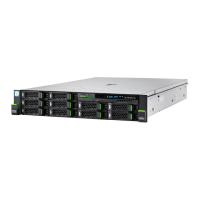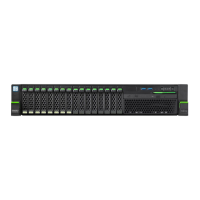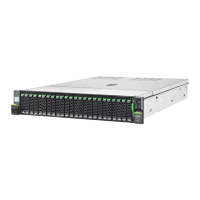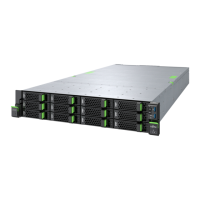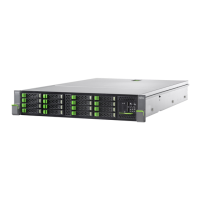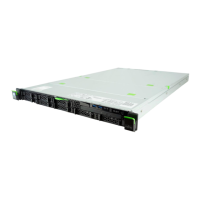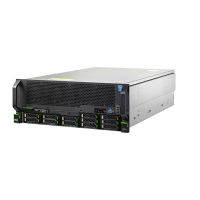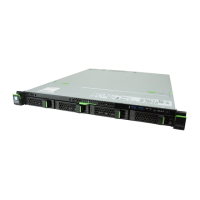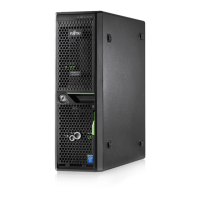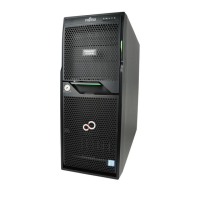Do you have a question about the Fujitsu PRIMERGY RX2540 M1 and is the answer not in the manual?
Explains symbols, fonts, and terms used in the manual for clarity.
Categorizes maintenance procedures by difficulty and required qualification level.
Provides time estimates for maintenance tasks, including preparation and completion.
Lists required tools and hardware for performing maintenance procedures.
Lists all necessary manuals and documentation for server maintenance.
Essential safety guidelines for installing, operating, and maintaining the server.
Information on environmentally friendly product design, energy saving, and disposal.
How to use diagnostics information to identify defective servers and components.
Procedure for safely shutting down the server before performing maintenance.
Procedures for gaining physical access to internal server components.
Steps for reassembling the server after maintenance or component replacement.
Instructions for connecting the server to the power supply.
Procedure for powering on the server after installation or maintenance.
Initial steps to prepare the server for maintenance, including software adjustments.
Temporarily disable or suspend BitLocker Drive Encryption before hardware modification.
Procedures to finalize maintenance tasks after hardware or software changes.
Instructions for updating or recovering system board BIOS and iRMC firmware.
Re-enabling BitLocker Drive Encryption after maintenance tasks.
Procedure for performing a RAID array rebuild after HDD replacement.
How to find changed MAC and WWN addresses after component replacement.
Overview of the server's power supply units and their capabilities.
Step-by-step guide for installing hot-plug power supply units.
Step-by-step guide for removing hot-plug power supply units.
Comprehensive guide for replacing a defective hot-plug power supply unit.
General procedures and guidelines for handling hard disk and solid state drives.
Information on installing HDD/SSD modules in 3.5-inch drive bays.
Guide for replacing SAS/SATA HDD/SSD backplanes.
Overview of the available system fans included in the system fan box.
Step-by-step guide for replacing a system fan.
Procedure for removing the entire fan box assembly.
Overview of the system board's expansion slots and their specifications.
Procedures for installing and removing standard expansion cards.
Instructions for installing expansion cards in riser modules (HL).
Information about Flash Backup Units (FBUs) and their function.
Information about DynamicLoM modules and their configurations.
Instructions for installing and removing the external COM1 connector.
Overview of the system board's memory slots and supported memory modules.
Step-by-step guide for installing memory modules into the system board.
Procedure for removing memory modules from the system board.
Comprehensive guide for replacing defective memory modules.
Overview of supported processors and their specifications for the system.
Step-by-step guide for installing processors onto the system board.
Procedure for removing processors from the system board.
Comprehensive guide for upgrading or replacing server processors.
Instructions for installing, removing, and replacing processor heat sinks.
Procedure for applying thermal paste to the processor surface for heat dissipation.
Overview of accessible drive bays and mounting order for front panel drives.
Instructions for installing and removing the optical disk drive (ODD).
Instructions for replacing the front panel module in 3.5-inch versions.
Instructions for replacing the front panel card.
Instructions for installing and removing the front VGA connector.
Instructions for installing and removing the front USB3.0 connector.
Procedure for replacing the front panel module on the rack mounting bracket.
Overview of key system board components like CMOS battery, UFM, TPM, and DynamicLoM.
Step-by-step guide for replacing the CMOS battery.
Instructions for installing, removing, and replacing the USB Flash Module (UFM).
Instructions for installing and removing the Trusted Platform Module (TPM).
Instructions for installing and removing the SATA DOM.
Instructions for installing and removing the SD card.
Comprehensive guide for replacing the server system board.
Lists all cables used in the server, their part numbers, and routing.
Diagrams illustrating cabling configurations for different HDD setups.
Provides a visual overview of the server's front and rear components.
Information on system board connectors, indicators, and front/rear panel controls.
Information on configuring onboard settings via jumpers and switches.
Steps to configure the server for minimum startup for troubleshooting.
Explains symbols, fonts, and terms used in the manual for clarity.
Categorizes maintenance procedures by difficulty and required qualification level.
Provides time estimates for maintenance tasks, including preparation and completion.
Lists required tools and hardware for performing maintenance procedures.
Lists all necessary manuals and documentation for server maintenance.
Essential safety guidelines for installing, operating, and maintaining the server.
Information on environmentally friendly product design, energy saving, and disposal.
How to use diagnostics information to identify defective servers and components.
Procedure for safely shutting down the server before performing maintenance.
Procedures for gaining physical access to internal server components.
Steps for reassembling the server after maintenance or component replacement.
Instructions for connecting the server to the power supply.
Procedure for powering on the server after installation or maintenance.
Initial steps to prepare the server for maintenance, including software adjustments.
Temporarily disable or suspend BitLocker Drive Encryption before hardware modification.
Procedures to finalize maintenance tasks after hardware or software changes.
Instructions for updating or recovering system board BIOS and iRMC firmware.
Re-enabling BitLocker Drive Encryption after maintenance tasks.
Procedure for performing a RAID array rebuild after HDD replacement.
How to find changed MAC and WWN addresses after component replacement.
Overview of the server's power supply units and their capabilities.
Step-by-step guide for installing hot-plug power supply units.
Step-by-step guide for removing hot-plug power supply units.
Comprehensive guide for replacing a defective hot-plug power supply unit.
General procedures and guidelines for handling hard disk and solid state drives.
Information on installing HDD/SSD modules in 3.5-inch drive bays.
Guide for replacing SAS/SATA HDD/SSD backplanes.
Overview of the available system fans included in the system fan box.
Step-by-step guide for replacing a system fan.
Procedure for removing the entire fan box assembly.
Overview of the system board's expansion slots and their specifications.
Procedures for installing and removing standard expansion cards.
Instructions for installing expansion cards in riser modules (HL).
Information about Flash Backup Units (FBUs) and their function.
Information about DynamicLoM modules and their configurations.
Instructions for installing and removing the external COM1 connector.
Overview of the system board's memory slots and supported memory modules.
Step-by-step guide for installing memory modules into the system board.
Procedure for removing memory modules from the system board.
Comprehensive guide for replacing defective memory modules.
Overview of supported processors and their specifications for the system.
Step-by-step guide for installing processors onto the system board.
Procedure for removing processors from the system board.
Comprehensive guide for upgrading or replacing server processors.
Instructions for installing, removing, and replacing processor heat sinks.
Procedure for applying thermal paste to the processor surface for heat dissipation.
Overview of accessible drive bays and mounting order for front panel drives.
Instructions for installing and removing the optical disk drive (ODD).
Instructions for replacing the front panel module in 3.5-inch versions.
Instructions for replacing the front panel card.
Instructions for installing and removing the front VGA connector.
Instructions for installing and removing the front USB3.0 connector.
Procedure for replacing the front panel module on the rack mounting bracket.
Overview of key system board components like CMOS battery, UFM, TPM, and DynamicLoM.
Step-by-step guide for replacing the CMOS battery.
Instructions for installing, removing, and replacing the USB Flash Module (UFM).
Instructions for installing and removing the Trusted Platform Module (TPM).
Instructions for installing and removing the SATA DOM.
Instructions for installing and removing the SD card.
Comprehensive guide for replacing the server system board.
Lists all cables used in the server, their part numbers, and routing.
Diagrams illustrating cabling configurations for different HDD setups.
Provides a visual overview of the server's front and rear components.
Information on system board connectors, indicators, and front/rear panel controls.
Information on configuring onboard settings via jumpers and switches.
Steps to configure the server for minimum startup for troubleshooting.
| Tcase | 72.6 °C |
|---|---|
| Bus type | QPI |
| Stepping | R2 |
| FSB Parity | No |
| Scalability | 2S |
| Processor code | SR207 |
| Processor cache | 15 MB |
| Processor cores | 6 |
| Processor model | E5-2620V3 |
| System bus rate | 8 GT/s |
| Processor series | Intel Xeon E5-2600 v3 |
| Processor socket | LGA 2011-v3 |
| Processor threads | 12 |
| Processor codename | Haswell |
| Execute Disable Bit | Yes |
| Motherboard chipset | Intel® C612 |
| Processor frequency | 2.4 GHz |
| Processor cache type | Smart Cache |
| Processor lithography | 22 nm |
| Processor manufacturer | Intel |
| Processor package size | 52.5 x 45 mm |
| Processor front side bus | - MHz |
| Processor boost frequency | 3.2 GHz |
| Processor operating modes | 64-bit |
| PCI Express configurations | x4, x8, x16 |
| Supported instruction sets | AVX |
| Thermal Design Power (TDP) | 85 W |
| Compatible processor series | Intel® Xeon® |
| Number of processors installed | 1 |
| Maximum number of SMP processors | 2 |
| Maximum number of PCI Express lanes | 40 |
| Memory types supported by processor | DDR4-SDRAM |
| Memory channels supported by processor | Quad |
| Memory clock speeds supported by processor | 1600, 1866 MHz |
| Memory bandwidth supported by processor (max) | 59 GB/s |
| Maximum internal memory supported by processor | 768 GB |
| HDD size | - \ |
| RAID levels | 0, 1, 5, 6, 10, 50, 60 |
| Optical drive type | DVD Super Multi |
| Supported HDD sizes | 3.5 \ |
| Total storage capacity | - GB |
| Maximum storage capacity | - TB |
| Number of HDDs installed | - |
| Number of HDDs supported | 4 |
| Supported storage drive interfaces | SAS, Serial ATA |
| Memory slots | 24 |
| Internal memory | 8 GB |
| Memory clock speed | 2133 MHz |
| Maximum internal memory | 1536 GB |
| Memory layout (slots x size) | 1 x 8 GB |
| LAN controller | Intel I210 |
| Cabling technology | 10/100/1000Base-T(X) |
| Ethernet interface type | Gigabit Ethernet |
| USB 2.0 ports quantity | 5 |
| PCI Express slots version | 3.0 |
| PCI Express x8 (Gen 3.x) slots | 3 |
| Operating temperature (T-T) | 5 - 40 °C |
| Operating relative humidity (H-H) | 10 - 85 % |
| Certification | CB, RoHS, WEEE, GS, CE, CSAc/us, FCC, VCCI, KC, CCC, C-Tick, CNS |
| Power supply | 450 W |
| Power supply input frequency | 47 - 63 Hz |
| Chassis type | Rack (2U) |
| Operating system installed | Windows Server 2012 R2 Datacenter |
| Compatible operating systems | Windows Hyper-V Server 2012 R2 Windows Server 2012 R2 Datacenter Windows Server 2012 R2 Standard Windows Storage Server 2012 R2 Standard Windows Hyper-V Server 2012 Windows Server 2012 Datacenter Windows Server 2012 Standard Windows Hyper-V Server 2008 R2 Windows Server 2008 R2 Datacenter Windows Server 2008 R2 Enterprise Windows Server 2008 R2 Standard VMware vSphere 5.5 VMware vSphere 5.1 Embedded VMware vSphere 5.1 SUSE Linux Enterprise Server 11 Red Hat Enterprise Linux 7 Red Hat Enterprise Linux 6 Oracle Linux 7 Oracle Linux 6 Oracle VM 3 |
| Processor ARK ID | 83352 |
| Intel Secure Key Technology version | 1.00 |
| Intel Identity Protection Technology version | 0.00 |
| On-board graphics card model | Not available |
| Depth | 770 mm |
|---|---|
| Width | 482.6 mm |
| Height | 86.9 mm |
| Weight | 25000 g |
